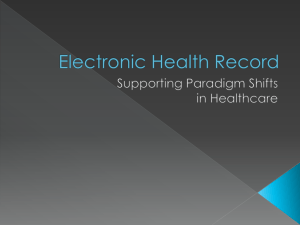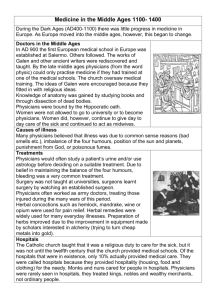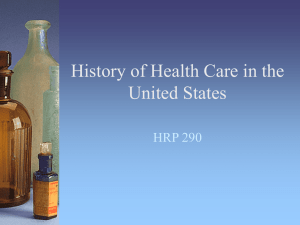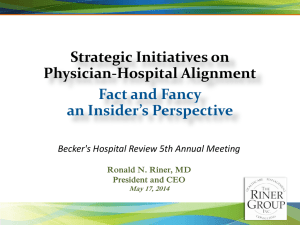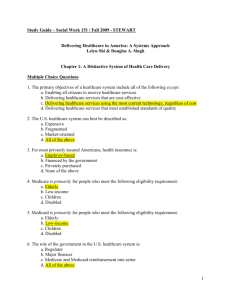Understanding Healthcare Organizations to Benefit Emergency
advertisement
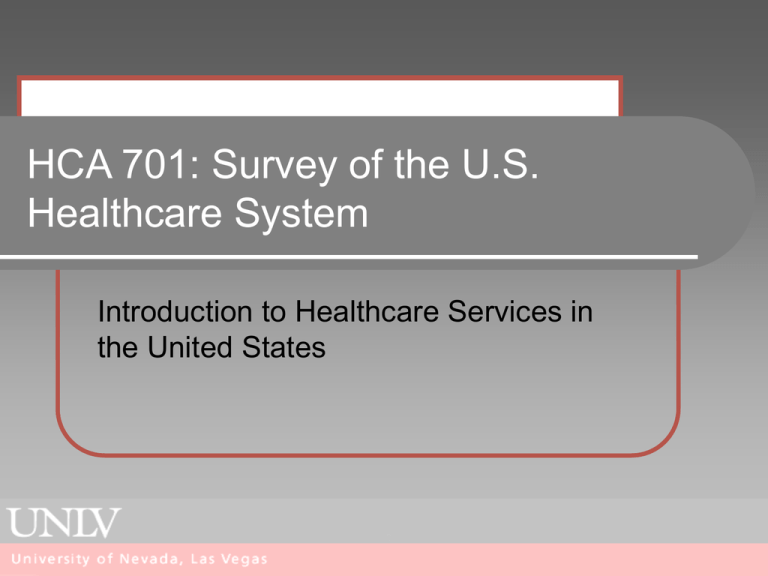
HCA 701: Survey of the U.S. Healthcare System Introduction to Healthcare Services in the United States RESOURCES NEEDED TO MAINTAIN A HEALTH CARE DELIVERY SYSTEM Financing Healthcare Professionals Health Care Delivery System Facilities Technology & Supplies Source: Williams and Torrens, Introduction to Health Services, 2002 BASIC SERVICE COMPONENTS OF A HEALTH CARE SYSTEM Public Health (Including Health Promotion and Disease Prevention) Emergency medical services (including transportation) Ambulatory care for simple/limited conditions Acute and community hospitals and medical centers Long-term care (either in-home or institutional care) Mental Health Services (both inpatient and ambulatory) Rehabilitation services (both inpatient and ambulatory) Dental services Pharmaceuticals/supplies/medical devices and equipment Brief History of the Development of the U.S. Health Care System 1850 – World War II 1850 – 1900 1900 – WWII Major targets at the time Epidemics of acute infections related to food, water, housing and other conditions of life Acute events, trauma, or infections affecting individuals not groups Technology available Virtually none Beginning of rapid growth of basic medical sciences & tech Social Organization for health care None; individuals left to their own resources or charity Societal/governmental efforts begin to care for those who can’t care for themselves Involvement of people in their health care People actively involved in giving care to family; little factual knowledge Medical knowledge begins to take shape in general public Issues Brief History of the Development of the U.S. Health Care System WWII - Present Issues WW II – 1980 1980 - Present Major targets at the time Chronic diseases such as heart disease, cancer, stroke Greater emphasis on chronic diseases, emotional/behavioral issues, occupational and genetic inheritance Technology available Explosive growth in medical science; technological takeover Continued advancement in technology contributing to rapid rise in health care costs Social Organization for health care Health insurance becomes primary vehicle for organization of health care Increasing power of financial organizations; increasing influence of governmental financial systems (Medicare, Medicaid). Involvement of people in their health care Health care becomes social and political issue Well-informed public but confusing complexity of system Life Expectancy at Birth Life Expectancy at Birth and at age 65 years 1900, 1950, and 2000 Classification for Health Status Today Disease – a state of dysfunction of the normal physiological processes manifested as signs, symptoms, and abnormal physical or social function (includes injury). Functional Ability – a process used to represent how independently an individual can perform or fulfill expected social roles (physical and mental). Quality of Life – multidimensional concepts of measures covering symptoms/problem complexes, mobility, physical activity, emotional well-being and social functioning. Blum’s Model of Factors Affecting Health Health Environment Lifestyle •Fetal •Attitudes •Prevention •Physical •Behavior •Cure •Socio/Cultural Biology Medical Care •Care •Rehabilitative Primary Cause of Death 1997 Source: Healthy People 2010 Healthcare Professionals Healthcare is a major employer It has a rapidly growing labor sector Professionals Non-professionals and technicians Non-institutional workers Rapid growth due to: Technology growth and specialization Health insurance coverage Aging population Emergence of hospitals Types of Healthcare Worker Certification Licensure – state or legal designation Certification and registration Independent and dependent professions Independents practice without physician supervision (e.g., doctors, dentists) Dependents need physician supervision (most nurses, CNAs) Physicians Comprised of two types by practice Primary care physicians – short supply in U.S. Family Practice, Internal medicine, OB/GYN, Pediatricians Specialists – Surplus in U.S. Specialize in specific areas Physician Surplus or Shortage? Rapid growth of physicians, esp. specialists, during 1980-95 due to: Maldistribution of physicians can give appearance of shortage Massive federal outlays Influx of International Medical Graduates (IMGs) Not enough primary care providers Medical underserved areas in rural communities and inner cities Malpractice and the impact on physicians Changing Role of the Physician More employed physicians By managed care organizations and hospitals (the emergence of the “Hospitalist”) Large group practices emerged with the growth of managed care Emphasis away from specialty areas to managed care More female physicians Distribution of Physicians by Specialty: 1980, 1986, 1995, 2000 (In thousands Specialty All specialties 1980 No./% 414/100 1986 1995 No./% No./% 521/100 630/100 2000 No./% 684/100 Pct. Change 1986-2000 31.4 Primary Care 159/38.5 179/34.4 205/32.5 219/32.0 22.2 Other Medical Specialties 25/6.2 62/12.0 83/13.2 94/13.7 50.2 Surgical Specialties 110/26.7 134/25.7 158/25.2 170/24.9 27.0 All other specialties 118/28.5 144/27.8 183/29.1 201/29.4 38.9 Will doctors meet demand in a bioterror event Nurses Typifies the concern of healthcare: “nursing is concerned with human response to health problems” Historic factors that shaped nursing as a career: Occupation to support physicians Emergence of hospitals as community institutions Acceptable female occupations, primarily white females Linked to religious orders Understanding the Nursing Shortage Changes in occupational opportunities for women since 1970s Majority of RNs are 50+ years of age or married with children at home Low salaries – pay compression Burnout Lack of clinical career ladder Active vs. Inactive – about 1/3 of nurses not working fulltime Ambulatory Care Personal health care given to the patient in an non-hospital or institutional setting Types of settings: Physician owned private practice Managed care clinic settings Community health care settings “Urgent care” facilities Shift to ambulatory care due to several factors: Medicare PPS Managed care Improved technology Patient Visits per 100 persons by Ambulatory Service Type, 1993-94 and 1999-2000 180 160 140 120 100 80 1993-94 1999-2000 60 40 20 0 Primary Care Visit Surgical Specialty Medical Specialty Practice Outpatient Dept. Emergency Dept. Hospitals The growth of Hospitals in the U.S. is a fairly recent history: Hill-Burton Hospital Insurance Advances in medical science Professional nursing Improved medical school training for physicians Cost containment practices have lowered hospital utilization Decreased inpatient utilization through DRGs and managed care Shift to outpatient services System and specialty hospital growth Hospital Classification For-profits – fastest growing type of hospitals For-profit and non-profit systems (e.g., Kaiser Permanente, Catholic Hospitals West) Public Hospitals Numbers are in decline Serve disproportionate number of Medicaid and uninsured Account for nearly 25% of uncompensated care Includes federally funded facilities such as VA and Armed Services facilities (McCallahan Federal Hospital) Hospitals (types cont.) Academic teaching hospitals Tripartite mission Face shaky future Rural Hospitals Small, non-profit Many with nursing home swing beds Endangered Quality of care in question Types of services available being lost to cities Number of Public Community Hospitals, U.S. 1,600 1,400 1,200 1,000 800 600 400 200 0 1991 1992 1993 1994 1995 1996 1997 1998 1999 200 2001 2002 Constraining and Propelling Forces Affecting Hospital Constraining Governmental and third party purchaser pressure for cost containment Competition from multihospital systems and local physicians Conservatism of some traditionally oriented practicing physicians Cost of continuing technological advances Slower growth of the economy Changing governmental philosophy toward health care Propelling New health markets other than inpatient care Weakening power of physicians in the hospital New organizational structures Increasing power of a more business-oriented management team Aging of the population Changing customer expectations for service Hospital Beds per 1,000 population by Ownership, 2002 Nevada U.S. State/Local Government Hospital Beds 17% 16% Non-Profit Hospital Beds 32% 71% For Profit Hospital Beds 51% 13% Background: Las Vegas Hospitals September, 2001 Total Govt. (n=2) Private, For-Profit (n=6) Private, Non-Profit (n=3) Number of Hospital Beds 2972 639 1963 370 Number of ER Beds 272 61 161 50 Isolation Beds 166 46 58 62 ER Clinicians 379 95 240 44 Security Staff 136 49 67 20 Decontamination Capabilities and Personal Protection Equipment, 2001 10 9 8 7 6 5 4 Yes No 3 2 1 0 Fixed Attached Showers Portable Showers M ultiple Staff ER Staff Other Full-Face Non-Encap. Shower Training for can Perform Breathing Air Purifier Chemical Capability Decon. Triage in Apparatus M ask Resistant PPE Suit Hospitals and Emergency Preparedness: Observation Areas and Data Collection 12 10 8 6 4 2 0 Yes No ea r A ... m ta on ... m te s Sy . t.. n e n tio c ne n o n V tio a ia g n v E i C ri n D m al rC on i S o a i t e t t o t i D f n g a S on a on te ia in r c e o M r M T e m A ir ta ll P ld n A ed n o a t o c io a nr C di at E t gn e v i n er an es -m ve n C D bs e o O N Pr on c e s re u os xp Mental Health Services Definition: Painful emotional symptoms…inability to think, remember or concentrate…increased potential of medical illness, pain, disability or even death Affects 30% of all adults Most mental illness is untreated 20-40% of homeless population is suffers from mental illness Mental illness is a crisis situation for Nevada hospitals Percent Distribution of Mental Health 24-hour hospital and residential treatment beds 90 80 70 State and county Private Psychiatric Non-federal general VA Med Centers RTCs All Others 60 50 40 30 20 10 0 1970 1976 1980 1986 1990 1994 1998 Who Gets Treatment for Mental Illness? 65% 20% 7% 8% Mental or Addictive illness receiving treatment No defined illness, received treatment Mental or addictive illness, not treatment No defined illness, no treatment
